SPP set a new record for summer peak demand Monday, the first of several that could come this week with a heat dome settled over the Great Plains.
The grid operator, which serves a 14-state footprint in the middle of the country, registered a peak demand of 56.18 GW at 4:27 p.m. (CT). That broke the previous mark of 53.24 GW set last summer by nearly 6%.
The record came as SPP was operating under a conservative operations advisory, declared because of the extreme heat, high load forecast and low wind forecast. The RTO issued another conservative operations advisory Tuesday. It also remained under previously declared resource and weather advisories; both have been extended until 8 p.m. Friday.
None of the advisories require public conservation and have been issued to raise awareness of potential reliability threats.
“It’s possible we may set another record,” SPP spokesperson Meghan Sever said in an email. “Stay tuned.”
Demand within the footprint hit 54.63 GW Tuesday afternoon, according to GridStatus.
About 143 million people in the country’s heartland were under heat alerts Tuesday. The National Weather Service is expecting high-temperature records to fall throughout the week, as the oppressive heat continues into next week.
Sitting almost squarely under the heat dome, parts of Kansas are under an excessive heat warning through Friday. Lawrence saw a heat index of 134 degrees Fahrenheit Sunday and Topeka broke an unofficial record at 127. Other cities in the region have seen, and will continue to see, heat indices approaching 120 degrees.
Sever says SPP expects to have enough generating capacity to meet the demand and its assessments don’t raise reliability concerns. The RTO’s summer reliability assessment indicated a 99.5% probability the system will have sufficient capacity to meet demand.
C.J. Brown, SPP’s director of system operations, said during a recent stakeholder meeting that the alerts and advisories are becoming regular.
“That’s been really challenging. Thankfully, we’ve had good renewable resource penetrations [on peak days],” he said. “We’ve teetered on [energy emergency alert 1] where it’s been really close, and a small contingency might have put us there, but we were able to make it through. That’s what I’m really calling the new normal.”
Tropical Storm Offers Relief to Texas
Tropical Storm Harold gave Texas a bit of a reprieve with rain in the south and cloud cover elsewhere. Average hourly demand failed to reach 80 GW for only the second time since July 29.
Austin had a 45-day streak of 100-plus temperatures broken when the thermometer only reached 99 degrees. However, Dallas extended its streak of 100-plus days to 41 Tuesday after having set an all-time high of 109 last week.
The cooler weather will be short-lived. ERCOT is projecting demand to once again approach record levels through Thursday.
The ISO did set another weekend peak demand mark Sunday at 85.12 GW, not far from the system’s all-time high of 85.44 GW. The ISO was forced to call for voluntary conservation when a large thermal unit went offline.




